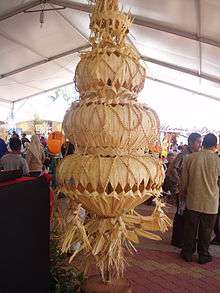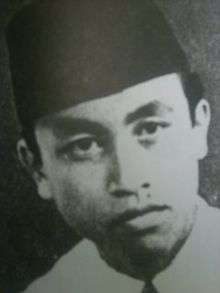Melanau people
| |||||
| Total population | |||||
|---|---|---|---|---|---|
| 132,600 (2014)[1] | |||||
| Regions with significant populations | |||||
|
(Sarawak) | |||||
| Languages | |||||
| Melanau, Malay | |||||
| Religion | |||||
| Islam, Christianity | |||||
| Related ethnic groups | |||||
| Dayaks, Bruneians, Orang Ulu | |||||
Melanau or A-Likou (meaning River people) are an ethnic group indigenous to Sarawak, Malaysia. They are among the earliest settlers[2] of Sarawak. They speak Melanau language, which is part of North Bornean branch of Malayo-Polynesian languages. In 2010, there are estimated to be 123,410 who consider themselves Melanau, making it the fifth largest ethnic group in Sarawak (after Iban, Chinese, Malays and Bidayuh). Even though a minority in Sarawak, Melanau forms a large part of Sarawak's political sphere, 5 out of 6 of Yang di-Pertua Negeri of Sarawak is of Melanau ethnicity including the current Yang di-Pertua Tun Pehin Sri Abdul Taib Mahmud and 2 out of 5 of Chief Ministers of Sarawak are ethnic Melanau.
Origins
.jpg)
In the 19th century, the Melanaus settled in scattered communities along the main tributaries of the Rajang River in Central Sarawak. Melanau or problematic Kajang speaking tribes such as the Sekapan, the Rajang, the Tanjung and the Kanowit gradually moved and assimilated into Dayak migrations settling in the Rajang. The Melanau people were regarded as a sub-group of the purported Klemantan people.[3]
Today the Punan (or Punan Bah) people are also closely linked to the last riverine dwelling Melanau communities previously inhabiting the middle and upper Rejang tributaries. The Kajang language is kept relatively alive by the isolated Sekapan communities Kapit division of Sarawak.
The Melanau are considered among the earliest settlers in Sarawak. The name Melanau was not used by the Melanau to refer to themselves until recently. They call themselves a-likou meaning 'people of the river'. Legend has it that the name Melanau was given by the Malays of Brunei to the inhabitants of the coastal swamp flats and riverbanks of central Sarawak which might signifies "coast-dweller".[4]
Eda Green, writing in 1909, referred to "... the Milanes, whose girls are as fair as any Europeans and the belles of Borneo."[5]
Divisions

Grouping-wise, the Melanaus can be classified into the followings;
- Melanau Matu-Daro
- Melanau Pulau Bruit.
- Melanau Dalat
- Melanau Oya
- Melanau Mukah
- Melanau Belawai-Rajang
- Melanau Rejang
- Melanau Balingian, and
- Melanau Miri.
The largest being the Matu-Daro group. Each group has its own characteristic dialect but they all share the same cultural and lingual background (Exception would be the Melanau Bintulu dialect which can hardly be understood by the rest. Many linguists feel that it hardly fits into the Melanau language grouping. This tribe is also known as "Vaie" whose language is very similar to Punan Lovuk Pandan and Punan Bah. Their early establishment were from Lavang and Segan riverine). The Melanau languages have been divided in the following eleven dialects[6]
Another Melanau group worth mentioning and inclusion is the Melanau Igan. They live in kampungs by Igan River (example : Kampung Skrang, Kampung Tengah, Kampung Hilir.) that borders the Mukah - (Matu-Daro) district. The main language is Melanau. However some speak local Malay dialect. This group of Melanau is probably all Muslims. They mainly adopt the Malay culture even though some of the Melanau cultures are still being maintained. It is believed that this group was originally Malays who settled in the area. However, mixed intermarriages with the Melanaus over generations produced new generations who considered themselves Melanaus.
Similar to the Igan Melanaus ancestral beginnings, many Melanaus who had migrated to different areas in Sarawak experienced the same transformation. A group of Matu Melanaus settled in Bintawa area in Kuching after World War 2. However their offsprings, even though mostly Melanaus by blood, normally do not speak the language. They are considered as Malays. However, as a point of interest, the new secondary school built in Bintawa Kuching in 2007 is named SMK Matu Baru. Many areas in Kuching notably Petra Jaya, Lundu and Santubong do have a significant Melanau population. Miri, Bintulu and Sibu are also places where there is a significant Melanau population.
However the 'Bin' which mean "son of" and 'Binti', meaning "daughter of" factors in all their names (be they are Muslim, Christian or "Likou") had probably confused the census workers (read the following paragraph). One of the reasons the Muslim Melanau 'migrated' to become Malay is that during the registration of birth of the newborns, they will automatically being assumed as Malay if the parents don't inform the birth and death registration officer of their racial preference.
Culture, religion and economy

The Melanau were traditionally fishermen as well as padi and sago farmers. Some were skilled boat builders. They used to live in tall stilt and long houses, but nowadays, they live in Malaysian kampung-style houses (individual & separated houses). Because of religious similarity, the majority of Melanaus live socially and culturally like the rest of the Malays in Malaysia.
It is one of the rare ethnic groups in Malaysia which hardly grows or increases in its population. This is because the Muslim Melanaus that have migrated to bigger towns in Sarawak have "automatically" become "Malays" especially during the National Census Operation as their names (and many times the language the elders use with their children at homes) are inseparable from the Sarawak local Malays. This has helped the Malay population of Sarawak to have significantly increased in the census.
Most Melanaus have a 'Bin' (son of) and 'Binti' (daughter of) in their names similar to the Malays[7] and it is also likely that the Christian Melanaus too were designated as Malays in the census.
The 2010 Malaysian Population Census showed the Melanaus population in Sarawak, Malaysia was about 123,410. They make up the 5th largest ethnic group in Sarawak, after the Ibans, Chinese, Malays and Bidayuh. The continuous inter-marriage between the Melanau and other races in Malaysia has also caused the disappearance of the Melanau identity. Data from some private research estimated that the actual Melanau population (in Malaysia and outside Malaysia) is much higher.
Being migrants in the early days, Melanaus are found almost everywhere in Sarawak. Sadly, though their children know their roots, many of them cannot speak or even understand their Melanau language. Intentionally or unintentionally, many of them have registered themselves as other races, mostly as Malays. In some cases, their parents, both Melanaus, prefer to speak Malay or English to their children. This language trend is mainly found in the towns and cities in Sarawak. There have been little efforts done to preserve the Melanau dialects and to teach the current Melanau generation continuous usage of their own dialects.
The gradual disappearance of the Melanau cultures and dialects is further aggravated by the absence of qualified Melanau staff members handling the documentation on the Melanau culture and history in the 'Majlis Adat Istiadat' department in Sarawak. This department is involved in the preservation and documentation of the cultures and histories of the various ethnic groups in Sarawak. The Melanau are slowly being emulsified into other cultures. The Melanau Kaul festival will only serve as a reminder of the Melanau Pagan ritual.
Religion
While originally animists, the majority of the Melanaus are now Muslim, although some of them, especially among the Melanau Mukah, and Dalat are Christian. Nonetheless, many still celebrate traditional rites such as the annual Kaul Festival. Despite their different beliefs and religions, the Melanaus, like other East Malaysians (Sabah and Sarawak) are very tolerant of each other and are proud of their tolerance. One can still come across a Melanau family with different children in the family embracing Christianity and Islam while their parents still have strong animist beliefs.
Melanau calendar
The Melanau have their own calendar which begins in March. The New Year is celebrated during the Kaul Festival.
Notable Melanau people
References
- ↑ "State statistics: Malays edge past Chinese in Sarawak". The Borneo Post. Archived from the original on 15 April 2016. Retrieved 15 April 2016.
- ↑ 'The Report: Sarawak 2008 Oxford Business Group, 2008
- ↑ Charles Hose; William Mcdougall (2015). Borneo Shamanism. Charles Hose. ISBN 605-176-617-0.
- ↑ "Melanau - Orientation". Retrieved 12 August 2014.
- ↑ Eda Green (1909). "Borneo: The Land of River and Palm". Project Canterbury. Retrieved 26 August 2008.
- ↑ Melanau Gordon, Raymond G., Jr. (ed.), 2005. Ethnologue: Languages of the World, Fifteenth edition. Dallas, Tex.: SIL International. Online version
- ↑ http://learn-melanau.blogspot.com/2011/01/why-melanau-use-bin-and-binti-in-their.html
- ↑ "2010 Population and Housing Census of Malaysia" (PDF) (in Malay and English). Department of Statistics, Malaysia. Archived from the original (PDF) on 1 March 2015. Retrieved 17 June 2012. p. 108



